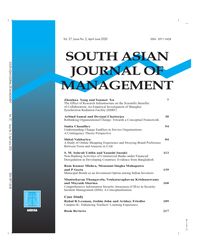An Exploration of Factors that Discriminate Hollands’ Six Occupational Categories:A Study of an Indian Working Population
Subscribe/Renew Journal
The research aims at identifying what combination of variables would significantly discriminate the six occupational categories as mentioned by Holland. The sample consisted of 300 working adults grouped into six occupational categories. Data was analyzed with the help of step-wise multiple discriminant functional analysis and five functions were evolved. Function I is named self-esteem, Function II – relationship oriented, Function III – creative problem solving, Function IV – gregariousness, Function V – self-oriented. Further analysis of all the five functions in relation to each of the six occupational categories it was found that Category 1 is high in self-esteem, average on relationship orientation, creative problem solving and gregariousness. It is slightly negative on self orientedness. Category 2 is average on selfesteem, relationship orientation, gregariousness and self orientation. This category is high on creative problem solving. Category 3 is negative on self esteem and relationship orientedness and average on creative problem solving, gregariousness and self orientedness. Category 4 is negative on self esteem, positive on relationship orientation and average on creative problem solving, gregariousness and self orientedness. Category 5 is positive on self-esteem and gregariousness, average in relationship orientedness and self orientedness and negative on creative problem solving. Category 6 is average on self-esteem, relationship orientation and self-orientation. This group is negative on creative problem solving and gregariousness. The findings provide validity for Holland’s theory in an Indian context. Further research starting from early adolescence has been recommended.
User
Subscription
Login to verify subscription
Font Size
Information

Abstract Views: 184

PDF Views: 0



